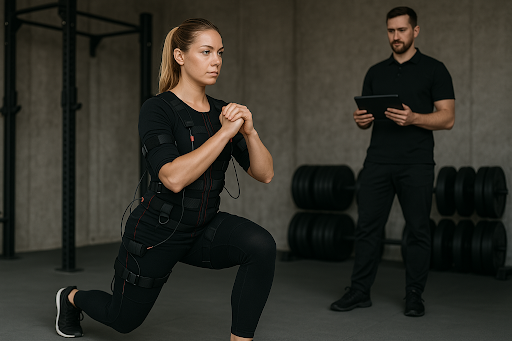Electrostimulation in Sports: Do EMS Suits Really Boost Performance?
Electrostimulation sounds like something from a sci-fi movie, right? Electrodes, impulses, muscle twitching on command. But it's very real. And in recent years, it has moved from physical therapy clinics into the world of elite sports and even everyday fitness. Athletes are strapping on full-body EMS (electrical muscle stimulation) suits with the promise of better strength, faster recovery, and less time spent grinding in the gym.
Some even compare the buzz around EMS to the excitement of online entertainment breakthroughs like those at
casinolab.org.uk, where high-tech meets fun. But back to business: does electrostimulation actually work? Let’s cut through the hype.

What Is EMS and How Does It Work?
Electrical muscle stimulation is nothing new. It's been used in physiotherapy for decades. Electrodes placed on the skin deliver tiny electrical impulses, forcing muscles to contract. It's a way to "hack" muscle activation without voluntary effort.
EMS suits take this up a notch. They combine electrodes into a wearable suit, covering major muscle groups. Controlled through a small device or app, these suits activate muscles across the body at once, often during simple movements or workouts. Think squats with your glutes firing at 100% capacity—not just because you're trying, but because the suit forces them to.
Here's what makes EMS different from just lifting weights:
• More muscle fibers activated: Electrical impulses can recruit deep muscle fibers often missed in traditional training.
• Lower joint stress: Since there's less weight involved, your joints get a break.
• Time-efficient: Sessions last 15-20 minutes, yet feel like a full workout.
Sounds slick, right? But does it hold up under real-world sports pressure?
EMS in Action: From Rehab to Peak Performance
Originally, EMS was a tool for injured athletes. You couldn’t train? No problem. Zap the muscles to keep them from wasting away. But today, even healthy pros use it as part of their strength and conditioning.
Sprinters, footballers, MMA fighters—they all experiment with EMS. It’s used either standalone or combined with exercises. For instance, doing lunges while the suit contracts your glutes and quads at full tilt.
In elite sport, milliseconds matter. Tiny gains can make the difference between gold and silver. So even a 1-2% improvement from EMS can be a game changer. Some athletes claim better posture, stronger core, quicker sprints.
Still, there’s skepticism. Science doesn't scream a unanimous yes. Results vary based on how EMS is used, fitness level, and individual response. Overhyped? Maybe. But useless? Far from it.
What Can You Really Expect From EMS Training?
If you think EMS will turn you into a superhero overnight, forget it. It's not magic. But if used right, it can bring serious perks. Here's what consistent EMS users report:
• Faster recovery: Especially post-game or post-heavy lift days. The low-frequency pulses help flush out lactic acid.
• Improved muscle tone: Many report visible changes even with minimal traditional exercise.
• Strength gains: Particularly in people who are new to training or coming off injury.
But here’s the catch: you still have to move. EMS isn't a "sit and shock" method. The best results come when it's paired with bodyweight or resistance exercises. Without movement, EMS alone does far less.
Common Misconceptions
To cut through some of the confusion, let's quickly bust a few EMS myths:
• "It replaces the gym"… Nope. It supplements training. Not replaces it.
• "It burns fat on its own"… Fat loss requires a calorie deficit, period. EMS won’t cheat biology.
• "It's unsafe"… For healthy individuals, EMS is generally safe if used properly.

When Should You Use EMS Suits?
EMS isn't for every training session. Overuse can cause muscle fatigue, and your nervous system needs time to adapt. That said, there are specific situations where EMS can really shine:
Ideal Scenarios for EMS Use:
1.
Rehabilitation
• Perfect for reactivating muscles after injury
• Can maintain strength when movement is limited
2.
Plateau-breaking
• 20-minute EMS sessions can replace longer strength work
• Great for business travelers or tight schedules
3.
Plateau-breaking
• Forces activation of stubborn muscle groups
• Adds variety to stale routines
Used smartly, EMS can add a new dimension to your training.
What to Look for in an EMS Suit
Not all EMS gear is created equal. Some look fancy but underdeliver. Here's a quick guide to avoid wasting money.
Key Features to Check:
• Number of channels: More zones = more precise control
• Adjustable intensity: Vital for tailoring sessions to your fitness level
• Mobile app integration: Makes tracking progress easier
• Comfort and fit: A poorly fitted suit ruins the experience
Bonus: Look for washable electrodes. Hygiene matters.
A good EMS suit isn’t cheap, but quality gear lasts and gives results.
Final Thoughts: EMS Is a Tool, Not a Shortcut
Here’s the honest take: EMS works, but it’s not a miracle gadget. It's a tool. Like kettlebells, resistance bands, or protein shakes. Use it wisely and it helps. Use it lazily and it’s just expensive gear in your closet.
Athletes and casual gym-goers alike can benefit, especially those looking to boost strength, fix imbalances, or recover faster. The trick is staying consistent, moving during sessions, and not expecting magic.
At the end of the day, you still have to sweat. The suit won’t do it all for you. But it might just give you that edge you’ve been chasing.

